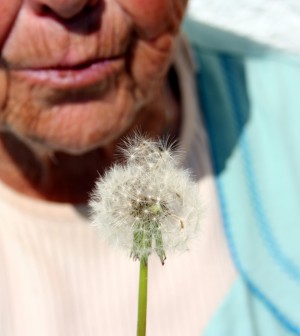- Navigating Your Midlife Crisis: Embracing New Possibilities
- City Raccoons Showing Signs of Domestication
- Mapping the Exposome: Science Broadens Focus to Environmental Disease Triggers
- One Week Less on Social Media Linked to Better Mental Health
- Your Brain Changes in Stages as You Age, Study Finds
- Some Suicide Victims Show No Typical Warning Signs, Study Finds
- ByHeart Formula Faces Lawsuits After Babies Sickened With Botulism
- Switch to Vegan Diet Could Cut Your Greenhouse Gas Emissions in Half
- Regular Bedtime Does Wonders for Blood Pressure
- Dining Alone Could Mean Worse Nutrition for Seniors
Many Americans 30 and Older Find Happiness Elusive

Americans 30 and older are less happy than generations past, while teens and 20-somethings seem more satisfied with their lives than ever, a new study finds.
Researchers said the pattern marks a striking reversal of what studies have traditionally shown — that, on average, people become happier as they mature.
It looks like that age advantage has disappeared. The average happiness rating among Americans aged 30 and older now matches that of younger Americans.
“A lot of the change has happened in just the past five years,” said lead researcher Jean Twenge, a professor of psychology at San Diego State University.
The reasons are not clear, said Twenge. But she speculated on some possible explanations.
Other research has shown that in recent decades, young Americans’ expectations about their future — their jobs, income, relationships — keep growing. But reality isn’t keeping up, Twenge pointed out.
“Around the age of 30 or so, you start to figure that out,” she said.
It’s also likely that recent cultural shifts are playing a major role, added Twenge.
She said social media — and the technology that keeps it at our fingertips 24 hours a day — may feed young people’s need for stimulation, attention or a sense of belonging to a large group of “friends.”
“Once you’re a little older, though, that doesn’t cut it,” Twenge said. “You may want to settle down, have more-stable relationships, and have a sense that you’re part of a community.”
James Maddux, a researcher who wasn’t involved in the study, agreed.
“Technology may be feeding a need for younger folks, but it’s just not enough for ‘older’ people,” said Maddux, a senior scholar at the Center for the Advancement of Well-Being at George Mason University in Fairfax, Va.
Compared with past generations, Maddux said, many more Americans live alone — owing to delays in marriage and a high divorce rate. And some traditional ways of connecting to community, such as going to church, are also on the wane.
Although other types of community groups abound, Maddux added, many Americans might not take advantage of them.
The findings — published Nov. 5 in Social Psychological and Personality Science — are based on surveys of 1.3 million Americans, aged 13 to 96, taken between 1972 and 2014.
In the early 1970s, about 38 percent of adults aged 30 and older considered themselves “very happy.” Between 2010 and 2014, that figure was down to 32 percent, the findings showed.
In contrast, the ranks of the “very happy” grew among 18- to 29-year-olds — from 28 percent in the early 1970s to 30 percent in the past few years. Teenagers’ happiness also increased, from 19 percent saying they’re “very happy” in the 1970s, to 23 percent in the 2010s, the researchers said.
On average, the happiness rating among people age 30 and up dropped to the same level as younger Americans’.
There were differences based on race and ethnicity, however. Among blacks of all ages, happiness ratings rose over the years. That, said Twenge, could be related to declines in racial prejudice — though it’s not clear why Asian and Hispanic Americans, like whites, showed an overall decline in happiness ratings.
Maddux said it would be interesting to see how education levels fit into the picture.
He pointed to a study published last week that found a recent rise in death rates among middle-aged white Americans with no more than a high school education. Those researchers found that much of the blame rested on “diseases of despair” — drug and alcohol overdoses, suicide and liver disease (which is often related to alcoholism).
In contrast, overall death rates were stable or on the decline among white middle-aged Americans with more education, according to the findings.
So it’s possible, Maddux said, that the happiness decline is especially acute among less-educated Americans older than 30.
The news is not all bad, though. Based on other research, Twenge said, people can try simple steps to boost their satisfaction with life.
If you tend to dwell on what you think you lack, she said try directing your attention to what you have.
“Some people suggest keeping a gratitude journal, where you write down something you’re grateful for every day,” Twenge said. “Or write a gratitude letter to someone in your life.”
Taking a walk and getting some sunshine every day, getting enough sleep, and spending time with people you like are all simple measures that can improve your sense of well-being, Twenge added.
More information
The Berkeley Greater Good Science Center has more on cultivating happiness.
Source: HealthDay
Copyright © 2025 HealthDay. All rights reserved.










